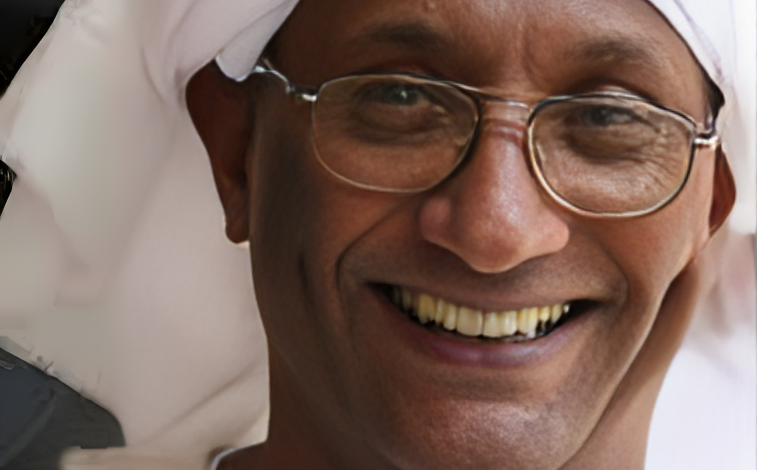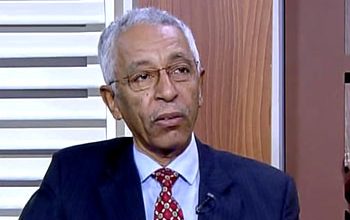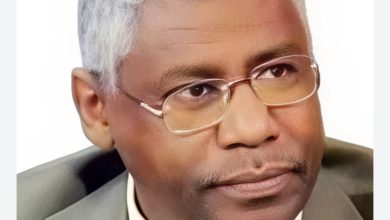The Ruins of the Sudan National Museum: Madness Has Its Methods

By Abdullah Ali Ibrahim
Summary
The destruction of the Sudan National Museum is madness—if you will. And madness, as Shakespeare said, has its methods, which we attempt to uncover here.
If the Rapid Support Forces (RSF) claim the Sudan National Museum is “Nubian and pagan,” then why did they also destroy a site that embodies their own Arab-Islamic identity—the Khalifa Abdullah House Museum, which commemorates the Mahdi of Sudan’s successor? They even stripped it of all its possessions, including “Emir Osman Digna’s prayer beads and Emir Abu Girja’s sword.”
After the RSF occupied the Sudan National Museum in June 2023, a soldier appeared in a video pointing to its ancient “pagan” statues from pre-Christian eras, saying, “These statues don’t represent me. I don’t belong to them. What represents me is not here.”
The video became something of a dark comedy when the soldier pointed to the mummies and said, “These are victims of the remnants. They killed their enemies and hid them here.” Comical or not, the video reignited the unresolved debate about Sudanese identity in relation to the country’s cultural diversity—an issue we’ll explore in this piece.
Another video, released after the Sudanese Armed Forces recently recaptured the museum, showed a museum almost entirely emptied of its over 100,000 artifacts, save for some heavy stone statues. The so-called “secure room” was destroyed, and its stored golden artifacts were looted entirely. The looting was facilitated by the fact that most of the museum’s contents were already boxed up for scheduled renovations. Mummies dating back to 2500 BCE were dragged from their preservation coffins and discarded in the exhibition hall. As the narrator put it, “They smashed artifacts they saw no value in and burned others.”
A French archaeological team, using satellite imagery, tracked the artifacts being loaded onto three trucks, which then drove out of Sudan, with South Sudan mentioned by name as a destination. Soon after, artifacts attributed to Sudan began appearing on online marketplaces like eBay, though authentication was lacking. Experts note, however, that it’s unlikely such stolen antiquities will enter the market quickly. European archaeologists and two other organizations have since begun monitoring for looted Sudanese artifacts and working to preserve Sudan’s heritage digitally.
Fortunately, international laws offer some protection. The UNESCO 1970 Convention prohibits illicit trafficking in cultural property. The International Council of Museums’ “Red List” protects endangered cultural property, and looted items are entered into Interpol’s art crime database. Recently, UNESCO’s executive board pledged comprehensive support to Sudan in culture and media, and cooperation with Interpol to recover stolen artifacts. There is precedent—UN Security Council Resolution 2099 (2000) banned trade in Iraqi and Syrian artifacts, prompting several nations to return stolen items.
One observer called the museum’s destruction “an attack on Sudan’s collective memory.” True—but the idea of a “collective” Sudanese memory has long been contentious, fueling political strife for decades. Destroying the museum is a form of madness—but, again, as Shakespeare said, madness has its methods. The RSF soldier’s remark about the absence of Arab-Muslim identity in the museum reflects those methods, justifying their destruction of the museum as irrelevant to their own cultural narrative.
Another RSF supporter mocked critics of the museum’s destruction, arguing that “these artifacts are from ancient Nubians on the Nile and have nothing to do with us. We are Arabs descended from Junayd, the forefather of the Baggara people of Kordofan, Darfur, and Chad”—a group widely seen as the RSF’s base. He declared they would instead erect a statue of Junayd in downtown Khartoum. As for the statue of the Nubian King Taharqa, “it’s gone to Chad forever,” he claimed.
What’s striking is that these RSF forces who destroyed the “Nubian pagan” temple also looted a museum dedicated specifically to their own Arab-Islamic identity—the Khalifa Abdullah House Museum. The voice in the video of its destruction said even Emir Osman Digna’s prayer beads and Emir Abu Girja’s sword were stolen. “This museum,” the voice added, “was built by the British in 1928, the same British who killed the Khalifa and crushed his state in Omdurman.”
Where did the RSF learn these “methods of madness” used to destroy temples and sacred sites? Who inspired them?
This leads us to a long-running discourse around Sudanese identity—a conversation that has unfolded not just over decades, but often under the shadow of violence. Since 1956, the central government in Khartoum, especially during the Islamist “Salvation State” (1989–2019), imposed a dominant Arab-Islamic identity on the nation, marginalizing other identities. Complaints have ranged from the dominance of Arabic in education and media, despite Sudan’s 100+ languages, to favoring ties with Egypt over Chad. The government’s commitment to the Palestinian cause was seen by some as irrelevant to Sudanese citizens.
Even the school textbook for primary reading features the Northern camel—a bizarre creature to children in camel-less regions of Sudan. People have even protested why palm trees dominate Khartoum’s cityscape while many other native trees are ignored.
This cultural imposition bred resentment in the periphery and contributed to Sudan’s ongoing conflicts. Researcher Chouhary Mohamed Mahmoud argued that Sudan’s cultural diversity should be understood not as mere plurality, but as a form of grievance—a consciousness of wasted abundance. If this grievance were properly channeled, it could guide political vision. But it was instead exploited by Arab-Muslim left-liberal elites at the center, as noted by researcher Abeer Mohamed Khair in her PhD thesis “The Politicization of Ethnicities and Its Impact on National Security” (1989–2020).
Of course, addressing marginalization inevitably involves politics. But there is a difference between politicizing grievances and opportunistically exploiting them for temporary gains. Abeer rightly blamed this exploitation on elite failures to build institutions that could address identity conflicts. Stripped of their traditional political arenas, these elites sought refuge in identity grievances—not as awareness, but as a tool to confront regimes.
They also embraced critical race theory, emphasizing minority identities oppressed by a dominant majority. While beneficial for marginalized groups, this approach often sidelined shared history and aspirations for unity. One American philosopher lamented that liberalism failed to offer a hopeful vision for national unity, retreating instead into identity silos. As he put it, liberals “burrowed into caves they dug for themselves, when they could’ve stood atop a great mountain”—the nation itself.
Ironically, this identity-driven agenda resembles the colonial-era British “Closed Districts” policy, which isolated Southern Sudan, the Nuba Mountains, and the Blue Nile to prevent their “contamination” by Arab-Islamic culture. The British feared these regions would be culturally “violated” like Northern Sudan, and instead promoted Christian missionary traditions and local customs. Much of today’s marginalization stems from those very colonial policies.
Scholar Kamal Osman Salih noted how Nuba youth lost military advancement opportunities due to British fears of Arabization through military service. The British banned them from the army and denied them national competition—not out of concern for their progress, but to protect them from Arabization.
The Sudan National Museum is the “great mountain” to which the cave-dwelling soldier brought his resentment—resentment that failed to rise to an awareness of the mountain, or the desire to hang his own cultural banner alongside others. No agreement between Sudan’s center and its peripheries has ever avoided the tension between the mountain and the caves. Even the 2020 Juba Peace Agreement, between the transitional government and Darfuri armed groups, featured demands to appoint their representatives to govern Khartoum itself—as if the capital belonged to them alone, regardless of democracy.
Perhaps the ultimate “cave-without-a-mountain” moment is Abdulaziz al-Hilu’s quasi-state in Kauda, Nuba Mountains, established in 2011. In his view, either the mountain accepts secularism—or he abandons it entirely.
The destruction of the Sudan National Museum is, indeed, madness—if you choose to see it that way. And, as Shakespeare said, “Though this be madness, yet there is method in’t.” We have tried here to uncover that method.



